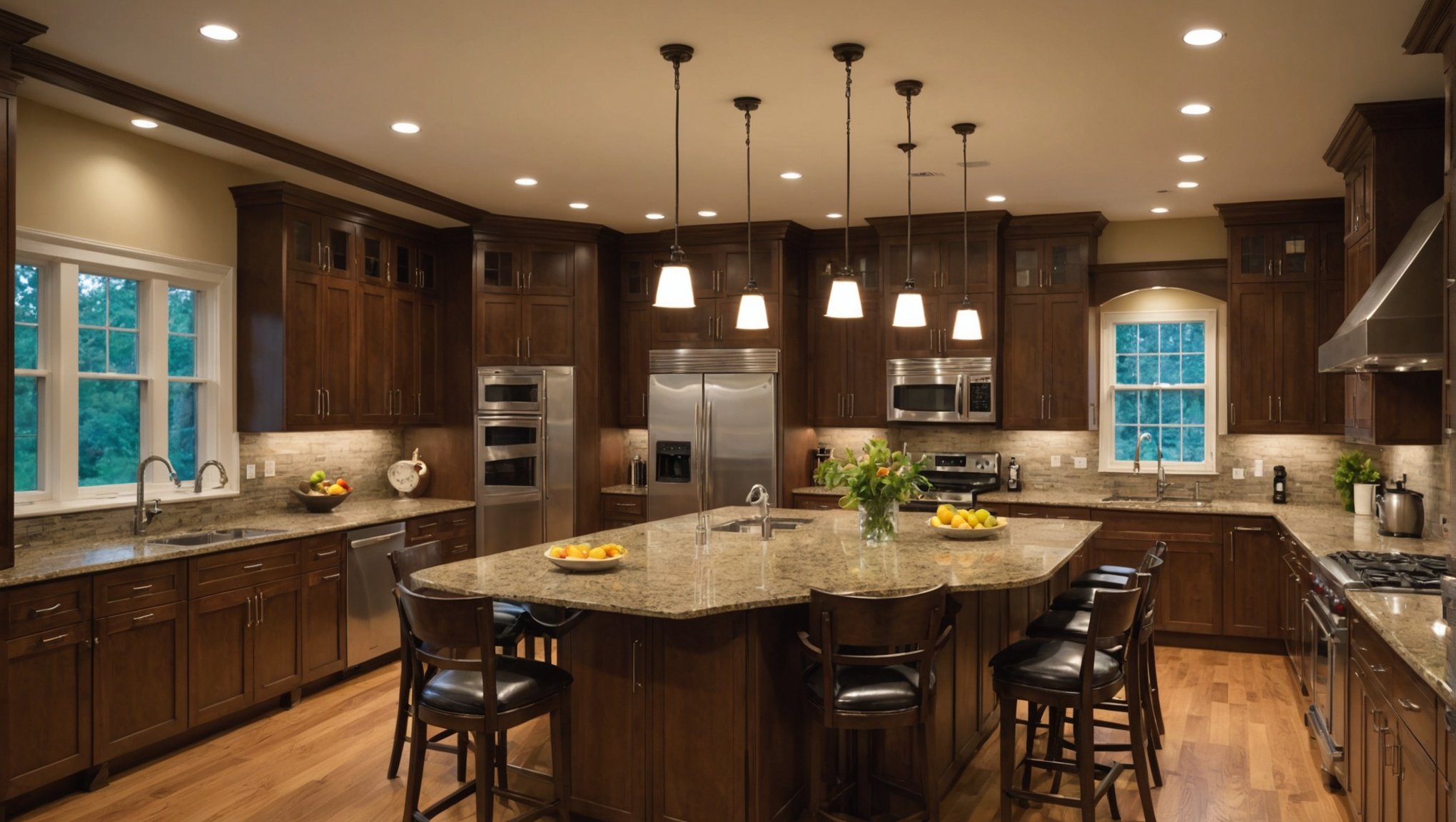Adjustable track lighting can revolutionize how we perceive our meals. Not only does it enhance the aesthetic of your kitchen, but it also influences portion sizes. This subtle manipulation of light can create an inviting atmosphere, encouraging mindful eating. Explore how the right lighting transforms your dining experience, shaping not just the look of your dishes but also your relationship with food. Discover practical tips for harnessing this innovative lighting technique and elevate your meal presentation today.
Importance of Lighting in Meal Presentation
The impact of lighting on food perception is profound, altering both the visual appeal and the overall dining experience. Lighting can transform the appearance of a meal, enhancing colours and textures, making dishes appear more appetising. Bright lighting tends to accentuate the vibrancy of food, highlighting its freshness and detail. Conversely, dim lighting can create a more intimate ambiance, which might make food look richer and more indulgent.
In parallel : Transform Your Kitchen: The Impact of Window Placement on Your Eating Schedule and Dietary Habits
Psychologically, lighting influences not just how food looks, but also how it is perceived in terms of portion size and appetite. Studies suggest that under brighter lights, people tend to eat less, as the food appears more substantial. In contrast, dim lighting can lead to overconsumption, as portions seem smaller and less filling.
Several case studies have highlighted the influence of lighting on dining experiences. For instance, restaurants with well-thought-out lighting designs often report higher satisfaction levels among patrons. Diners frequently perceive meals as tastier and more satisfying when the lighting complements the dish presentation. Thus, understanding and utilising the right lighting can significantly enhance meal presentation and elevate the dining experience.
Also read : Transform Your Kitchen: The Impact of Window Placement on Your Eating Schedule and Dietary Habits
Understanding Adjustable Track Lighting
Adjustable track lighting is a versatile lighting solution that allows for the direction and focus of light to be manipulated according to specific needs. This type of lighting consists of a series of light fixtures attached to a continuous track device, which can be mounted on ceilings or walls. The adjustable feature enables users to pivot and rotate the lights, directing illumination precisely where it is needed.
In kitchen settings, track lighting offers several benefits. It provides focused light that can enhance meal presentation, highlighting the colours and textures of dishes. Unlike traditional fixed lighting, adjustable track lighting can be tailored to illuminate specific areas, such as countertops or dining tables, ensuring optimal visibility. This adaptability makes it particularly advantageous for tasks requiring precision, like food preparation and plating.
When compared to other lighting options, adjustable track lighting stands out for its flexibility and functionality. While pendant lights offer a fixed source of illumination, track lighting can be adjusted to suit different occasions and settings. Recessed lighting, though sleek, lacks the directional capability that track lighting provides. Thus, for those seeking a dynamic and effective lighting solution, adjustable track lighting is an excellent choice.
Design Tips for Implementing Track Lighting in Kitchens
When considering kitchen lighting design, several key principles can enhance both functionality and aesthetics. To achieve optimal results, it’s essential to consider how track lighting can be positioned to highlight specific areas and improve food presentation.
Key Design Principles
- Layering Light: Combine track lighting with other light sources, such as under-cabinet or pendant lights, to create a balanced and layered lighting environment. This approach ensures that the kitchen is well-lit for various tasks while maintaining a warm and inviting atmosphere.
- Positioning for Presentation: For effective food presentation, position track lighting to cast light directly onto countertops and dining areas. This not only accentuates the colours and textures of meals but also provides ample illumination for food preparation.
Choosing Fixtures and Bulbs
Selecting the right fixtures and bulbs is crucial for adjustable track lighting. Opt for fixtures that allow for easy adjustment and rotation to direct light where needed. LED bulbs are recommended for their energy efficiency and ability to emit bright, clear light. Consider bulbs with a high colour rendering index (CRI) to better showcase the natural colours of food, enhancing the overall dining experience.
Enhancing Meal Presentation with Lighting Techniques
In the realm of meal presentation techniques, lighting plays a crucial role in accentuating the visual appeal of dishes. One effective method is using adjustable lighting to highlight specific dishes. By directing focused beams of light onto a particular dish, you can draw attention to its details, enhancing the overall dining experience. This technique can be particularly effective for showcasing signature dishes or intricate plating designs.
Another important aspect is the use of colour temperature to enhance food appeal. Warmer light tones can make food look more inviting and appetising, while cooler tones may be used to highlight freshness and crispness. Adjusting the colour temperature according to the type of meal can significantly influence how it is perceived by diners.
Creating focal points in meal presentation through lighting can also be achieved by strategically placing light sources to guide the eye towards key elements of the dish. This can be done by using a combination of spotlights and ambient lighting to ensure that each component of the meal is properly illuminated. By employing these meal presentation techniques, you can transform a simple dining experience into a visually captivating event.
The Relationship Between Lighting and Portion Sizes
Understanding the relationship between lighting and portion perception can greatly enhance dining experiences. Lighting not only affects how food is seen but also how its quantity is perceived. Bright lighting can create the illusion of larger portions, making meals appear more substantial than they are. This can lead diners to feel more satisfied with less food, as the vividness of the meal is accentuated.
Conversely, dim lighting tends to make portions seem smaller and less filling, which can result in overconsumption. Research supports these observations, highlighting that lighting conditions significantly influence how diners perceive portion sizes. Studies have shown that individuals under bright lights are more likely to estimate their portions as larger compared to those dining in dimly lit environments.
To leverage lighting for managing portion perceptions, consider these tips:
- Use brighter lights in dining areas to make meals appear more abundant, which can help with portion control.
- For a more intimate setting where indulgence is encouraged, opt for softer, dim lighting.
- Experiment with adjustable lighting to find the optimal balance that suits the dining experience you wish to create.
Practical Applications of Adjustable Track Lighting
Incorporating adjustable track lighting in kitchens offers numerous practical benefits. This versatile lighting system allows homeowners to tailor illumination to suit various culinary tasks and dining experiences. Real-world examples show that many modern kitchens use track lighting to highlight specific areas, such as kitchen islands or dining tables, enhancing both functionality and aesthetics.
For best results, consider adjusting the lighting based on the meal type. For instance, when preparing intricate dishes, direct the light to provide focused illumination on the workspace, ensuring precision and clarity. For casual dining, softer lighting can create a relaxed atmosphere, while brighter settings can accentuate vibrant dishes during formal dinners.
Integrating smart technology with adjustable track lighting further enhances its utility. Smart systems enable users to control lighting intensity, colour temperature, and direction through apps or voice commands. This integration allows for seamless transitions between different lighting settings, catering to various culinary needs and dining moods. By leveraging these track lighting applications, kitchens become more adaptable and efficient, offering an elevated cooking and dining experience.
Visual Aids for Effective Meal Presentation
Visual aids are crucial in understanding the impact of lighting on meal presentation. They not only illustrate the transformative power of lighting but also guide individuals in optimising their dining environments. By comparing before-and-after scenarios, one can clearly see how adjustable track lighting enhances the visual appeal of dishes.
Examples of Before-and-After Scenarios
Consider a dining table set under standard lighting. The colours of the meal might appear muted and less inviting. By implementing adjustable track lighting, the same setting can be transformed. The vibrant hues of vegetables, the glistening texture of sauces, and the intricate details of garnishes become more pronounced, making the meal visually enticing.
Creating a Visual Guide
To maximise the effectiveness of meal presentation, it’s beneficial to create a visual guide. This guide can include:
- Lighting angles: Demonstrating optimal angles to highlight key dish elements.
- Colour temperature settings: Showing how different temperatures affect food appearance.
- Before-and-after comparisons: Providing concrete examples of lighting impact.
By utilising these visual presentation techniques, individuals can achieve a more appealing and satisfying dining experience, enhancing both the aesthetic and sensory aspects of meals.
Common Mistakes to Avoid with Kitchen Lighting
In the realm of kitchen lighting, certain missteps can diminish both functionality and aesthetics. Understanding these pitfalls is crucial for creating an inviting and effective space.
Common Pitfalls in Using Adjustable Track Lighting
Adjustable track lighting, while versatile, is often misused. A frequent mistake is over-lighting, which can create harsh environments that detract from the warmth of a kitchen. Conversely, under-lighting can obscure workspaces, making tasks like food preparation difficult. To avoid these, balance is key: ensure that lighting is neither too intense nor too dim.
Tips for Maintaining Flexibility in Kitchen Lighting Design
Flexibility is a hallmark of effective kitchen lighting. To maintain it, consider these tips:
- Layer lighting: Combine adjustable track lighting with ambient sources to create a dynamic environment.
- Regular adjustments: Frequently adjust the direction and intensity of lights to suit different tasks and times of day.
- Use dimmers: Incorporate dimmer switches to easily modify lighting levels, enhancing both functionality and mood.
By avoiding these kitchen lighting mistakes and implementing strategic adjustments, your kitchen can remain both practical and visually appealing.
Future Trends in Kitchen Lighting and Meal Presentation
The future of kitchen lighting is set to be shaped by several emerging trends that promise to revolutionise how we illuminate our culinary spaces. One such trend is the integration of smart lighting systems. These systems allow users to control lighting settings via apps or voice commands, offering unprecedented flexibility and personalisation. As technology advances, expect these systems to become more intuitive, adapting automatically to different cooking and dining scenarios.
Sustainability is another critical factor influencing the future of kitchen lighting. With growing environmental awareness, energy-efficient solutions like LED lighting are becoming increasingly popular. Future designs will likely focus on reducing energy consumption, incorporating solar-powered options and sustainable materials to minimise environmental impact.
In terms of meal presentation, lighting is expected to play an even more significant role. Dynamic lighting, which can change colour and intensity, will enhance the dining experience by highlighting dishes in new and exciting ways. This evolution in meal presentation will not only make dining more visually appealing but will also cater to the growing trend of sharing food experiences on social media. Thus, the future of kitchen lighting is both innovative and environmentally conscious, offering exciting possibilities for enhancing culinary experiences.






